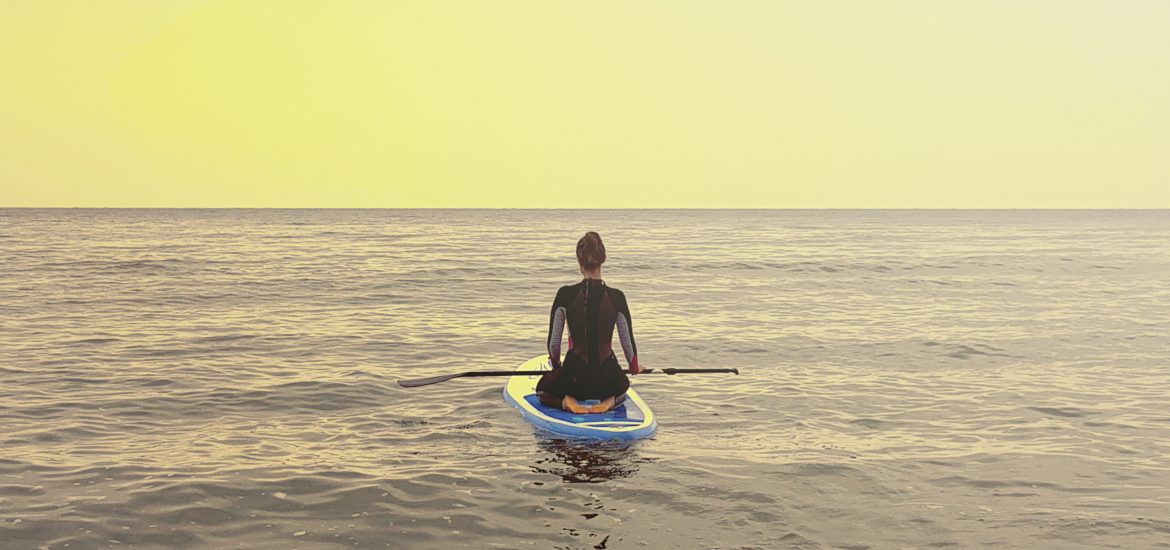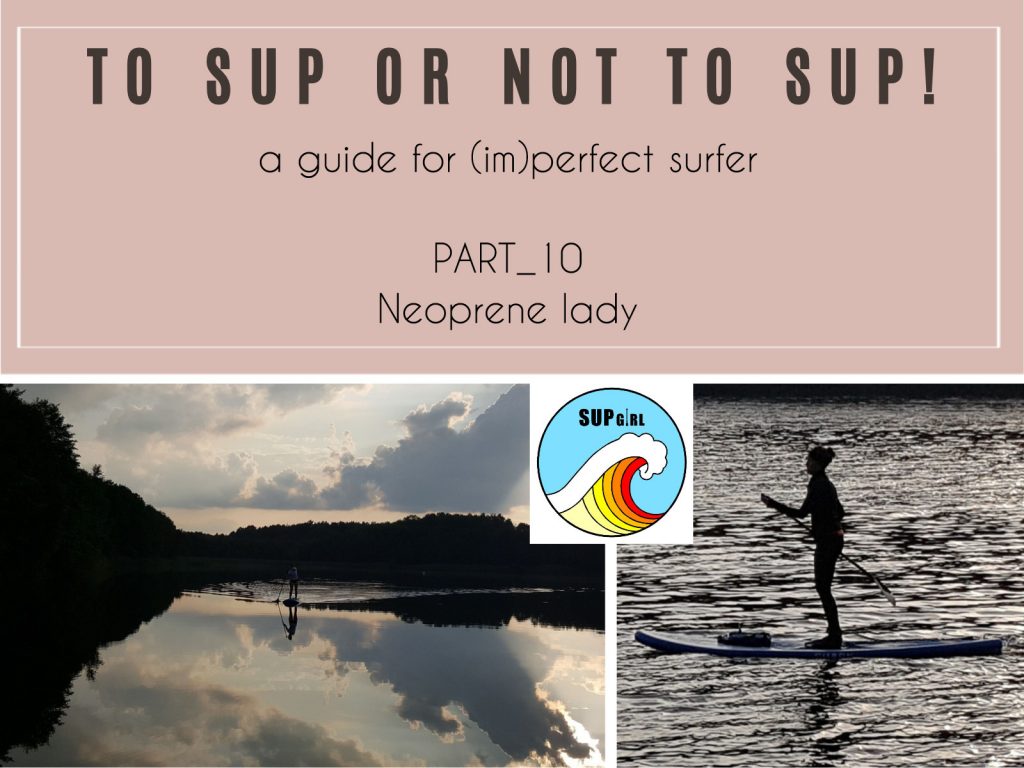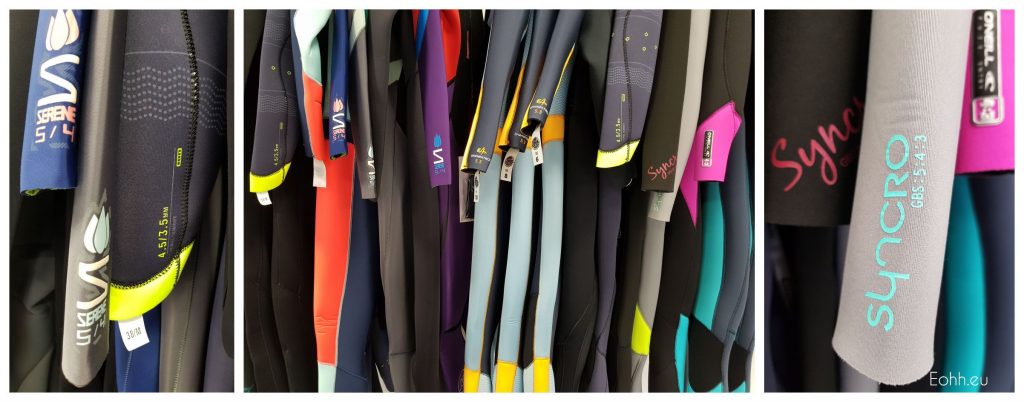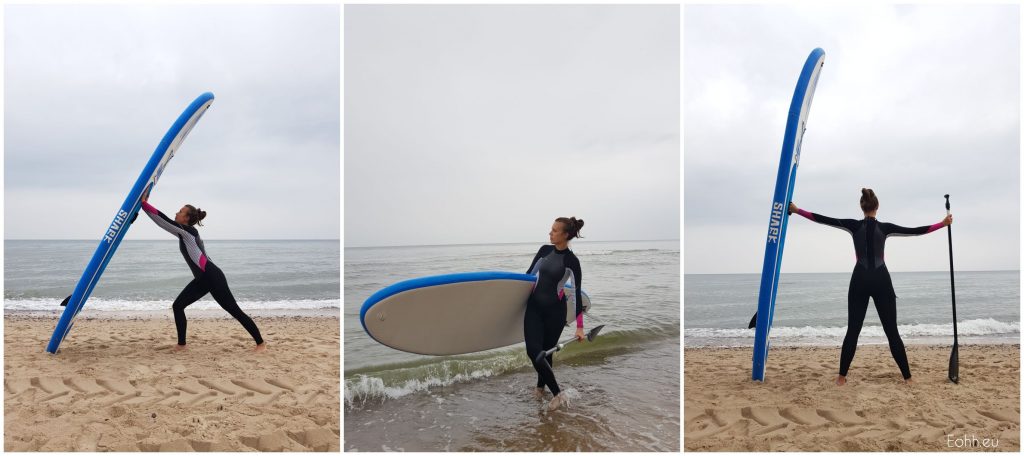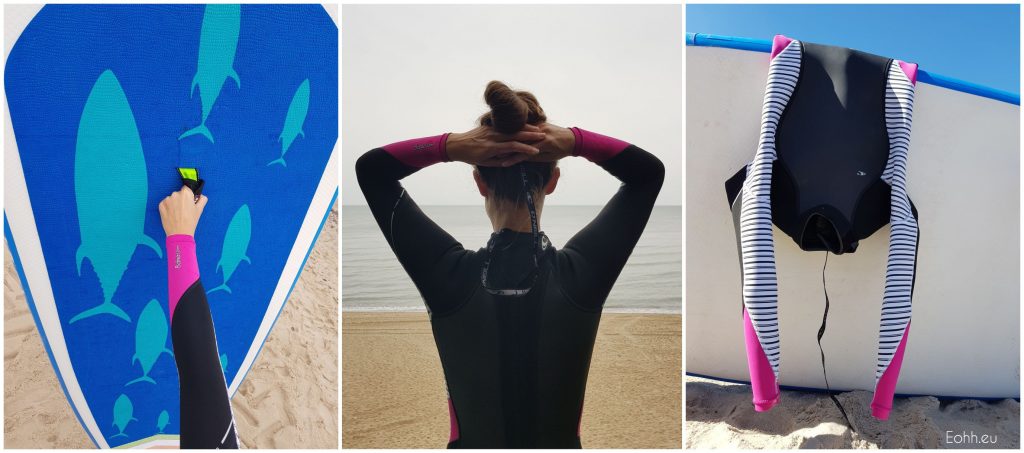I faced a challenge at the beginning of September. It wasn’t a sporting challenge but a purchasing one. I thought that choosing the SUP board was the most difficult moment of collecting the gear for me. The selection of wetsuit became an equally demanding one for me.
I had been preparing myself for the purchase of a wetsuit for almost a year. I wanted to avoid a rash choice. I gave myself time to increase the sport budget and save a reasonable amount of money as well as getting some factual knowledge. Apart from collecting information on the Internet I consulted Nadia a lot, receiving practical background in this subject from her. The more I knew, the more lost I felt. The amount of information suppressed me. The frustration appeared when I realized that I wasn’t able to buy my dream, colour, modern designed wetsuit on-line. The thickness of a material and the right size were two main dilemmas.
I expect my wetsuit to give me thermal comfort during floating on my board after summer. I hesitated between 4/3 and 3/2 material thicknesses. I finally rejected 4/3 which seemed too warm to me, because I rarely fall into the water especially when floating on the lakes. I still have doubts if 3/2 wetsuit bought by me is enough to protect my body during the winter too.
I feel subconsciously that it won’t work. When I surf at the seaside in bad weather conditions means, for me, frequent baths in the water! I don’t want to think about that now. Testing the wetsuit and checking my abilities are my tasks for the upcoming cold months. I wonder if I will find the critical temperature to which I dare not enter the water. In the worst case I will end up buying another warmer wetsuit.
Today being the lucky owner of the wetsuit, having shopping dilemmas behind me, I may truly compare the purchase of the wetsuit to buying a bra. I think it is the most troublesome part of woman’s clothing into which we put a lot of effort. It mostly requires a professional assistant who helps us select the perfect model, so the one which we will feel comfortable in. Proper fitting requires the same effort and stress. Ok, there is one difference: you put a bra on as quickly and easily as you take it off. Trying the wetsuit goes much slower.
A good wetsuit is the one well fitted to a person’s body. But how do we know what is ideal for us especially when we buy such product for the first time? The best solution is to try it on.
I came to the Energy Sports store this time as in the case as buying my SHARK. I did the preliminary research in July. Mr. Krzysztof hanged several models in front of me after a short interview trying to meet my preferences and needs. I was fed up after trying the first one. It is not an easy task on hot days. It is not pleasant for those who don’t wear tight clothes daily and don’t like to be “compressed and squeezed” by the closeness of the material on the body. The effort resulted in sweat, nerves but finished with my victory. I found a colorful, very feminine model for myself.
Another and the last approach to buy the wetsuit took part at the beginning of September. Unfortunately, the wetsuit chosen by me last time wasn’t there anymore. The choice was limited by the summer sale which encouraged people to buy at low prices. Mr. Krzysztof went into action once again, giving me a try this time – to my disappointment – of almost all monochromatic models. I rejected chest zip wetsuits. They didn’t find my approval after the first attempt to put it on. I hoped this model would be a more practical solution than a back zip wetsuit and would assure me of independence in putting on/taking it off. Alas, pulling my head over the flap was the worst stage for me. Should I mention about difficulties in removing it too?
I bought, in the end, the model Bahia 3/2 O’Neill brand, black one with white gussets on the both sides and pink cuffs, with a zip at the back.
A smile returned to my face when it came to pay. I saved 25% of the budget thanks to which I can think about another investment, such as: professional neoprene gloves.
Although the black colour of the wetsuit didn’t meet my presonal preference, its technical parameters suit my needs best. Colour doesn’t matter, what counts is the functionality. The longer I use my wetsuit the more I like it. Each time I look at photos I feel that my choice was right, and to be honest I appear better in it than in the colour I wanted at the beginning. Besides, black absorbs heat from the sun, so I will feel warmer when floating in the cooler months.
I have already chosen my wetsuit. It is time for you, girls.
Those who face the challenge of purchase I recommend the following interview with Mr. Krzysztof – super advisor from the Energy Sports store, a master of patience when the customer is an undecided woman. Shopping? – only with his help.
I think we managed to gather the essence of practical knowledge in this short conversation that will allow you to specify your own needs and make it easier to decide when choosing the perfect wetsuit for you. Feel invited to the interview.
Engineer on High Heels: Why do we need a wetsuit?
Krzysztof Energy Sports: The wetsuit is necessary for people who want to swim, do water sports in cold days, in low temperatures when the water isn’t warm enough.
EoHH: What material are wetsuits made of?
K ES: It is the neoprene that comes in various forms. We have a neoprene mesh rubberized one. It is the warmest, the most delicate material, not very stretchy. The neoprene jersey is a neoprene laminated both sides with polyester-nylon material that improves the strength of neoprene, including resistance to abrasion. The pros are: durability, flexibility and what is very important comfort. It is slightly less warm than mesh neoprene. Neoprene with both material combinations are also available on the market.
EoHH: What is important when choosing the wetsuit?
K ES: The time of use and the purpose – what it is meant for – are the factors determining the choice of the wetsuit. This basis is required to select neoprene thickness as well as the model – the length of the wetsuit. The perfect fit is a significant aspect. The wetsuit must cover tightly the person’s body to fulfill it’s function.
EoHH: What else should we pay attention to?
K ES: Comfort. Fit all over your body as I mentioned before. The wetsuit should not be baggy or too long. I would rather not pay attention to the ease of putting on and taking off, because we usually do it once for each session at least when it comes to: SUP, surfing, windsurfing, kitesurfing.
EoHH: Which criteria should a perfect wetsuit meet?
K ES: Excellent fit. The wetsuit should be tight to the body to let you ensure a thermal comfort especially during spring and autumn. I would rather recommend to practise water sports at lower temperatures in semi – dry suit. The wet one works well only in the warm water. It warms your body a little.
EoHH: What with the wetsuits for winter?
K ES: The semi – dry suits. Their work is based on keeping and warming the water inside the suit. However, the water change inside the suit is minimalized because of special material used in places such as: neck, wrists, ankles.
A dry suit is a waterproof alternative. It prevents water entering the suit and stops cooling effects of the wind. There is no need to put on anything more under it. It can be made of neoprene as well.
EoHH: What do the numbers on the cuffs mean?
K ES: It represents neoprene thicknesses in mm. For example: for neoprene marked 5/4 the first value gives the material thickness on the torso. The other are limbs. The thicknesses can be spread a bit differently. The forearms and calves can be thinner and the rest of the body thicker. Moreover, three values can be given, e.g. 5/4/3 which mean that the torso usually has 5mm, the sections till knee and till elbow 4mm, forearms and calves 3mm.
EoHH: What influence has the seams construction?
K ES: The neoprene panels are joined by stitching which involves making holes in the material and threading. The technology of making the seams affects the permeability of the wetsuit, so getting the water into it and consequently the thermal comfort of the user. There are 2 types: flatlock and blindstitch.
Flatlock it is the simplest stitching method which pierces the material through. It is not stretchy, so it stiffens the wetsuit in the place. The neoprene can be flexible itself but it locks on the seam. The water and wind are transmitted by this type of seam, hence it is used in the simplest wetsuits: thin and short dedicated to warm water. The wetsuits with flatlock are comfortable and ensure a wide range of motion.
Blindstitch is used on “high class” wetsuits, although you may find this type of seams in wetsuits from the second bottom price shelf. The technology consists in guiding the needle half way through the material thickness. It means that the material is not breaking through the opposite side thanks to which not only the water and wind penetration inside the wetsuit is reduced but also the risk of hypothermia is minimalized. Such a seam is much more stretchy, comfortable. The wetsuits with blindstitch are the best for sports requiring continuous arms work where the wide range of movement is necessary, like: SUP, surfing, windsurfing, kitesurfing.
This stitching technology combines other versions when special glue and tapes are used. Those components make the seams waterproof and windproof, besides providing better joint protection. It hasn’t any impact on material flexibility.
EoHH: How much money should we spend?
K ES: It is hard to say. It is an individual matter. It depends how big a budget you have. It is obvious that bigger price means better quality. The upper shelf wetsuits will be made of a more stretchy material and have more insulating materials inside which provide the thermal comfort. The wetsuits with satisfying parameters are priced between 110 € – 150 €.
EOHH: Any manufacturers to recommend?
K ES: The situation on the market changes dynamically. O’Neill for sure. Excellent wetsuits. They offer very comfortable neoprene. I recommend Xcel producing very warm wetsuits made of high quality materials. Maybe a little less comfortable than O’Neill but very, very warm due to the neoprene thickness and warming material inside.
InO: What to do if the product didn’t meet our expectations?
K ES: It is very difficult to return the wetsuit, if it has already been worn. The secondary market is the place where you should consider to sell, if the wetsuit doesn’t come up your needs.
InO: I understand that it is the only option, isn’t it?
K ES: Unfortunately. I haven’t experienced yet anything like altering the wetsuit, just as we give our clothes to the tailor. There is a company that repairs wetsuits in Trójmiasto. They can replace panels in the case of neoprene damage. The repairs are done very professionally, so the quality is the same as the original.
EoHH: How long can the wetsuit be in use?
K ES: It depends how often we use it. It may last from 2 – 3 seasons to even 10. It depends how we use and care for it. If someone is a “Sunday wearer” who consciously uses, preserves and stores, it will last for a very long time. If someone catches every opportunity just to enter the water to swim, float or wear the wetsuit often like instructors, enthusiasts of water sports I think that these are 2 – 3 seasons. You must remember that the wetsuit while using will lose some of its functions in time.
EoHH: Thank you for conversation and your time.
K ES: My pleasure.
So, do you know everything? Are you going hunting for one? Try! Patience guarantees success.
Good luck!
